Modifying Object Properties for Formatting Purposes
Now that the foundation of our report is complete, it is time to focus on how to improve the form and aesthetic appearance of the report.
By modifying various object properties, the presentation value of the report can be greatly improved. In doing so, you will be using the Format Editor to access a variety of specific properties, such as fonts, borders, colors, and alignment. The Format Editor is a commonly used dialog to quickly and easily modify all report objects, and its contents are reflective of the specific object type being formatted (text, chart, database field, and so on). To explore these formatting capabilities, follow these steps:
- Continuing with the report from the chapter's earlier exercise, return to the Design tab of your report and right-click on the report title text object (located in the Report Header section) and select the Format Text option from the list, as shown in Figure 6.7. This opens the Format Editor dialog.
Figure 6.7. The Format Editor dialog is accessed from the right-click pop-up menu on most Crystal Reports' objects.
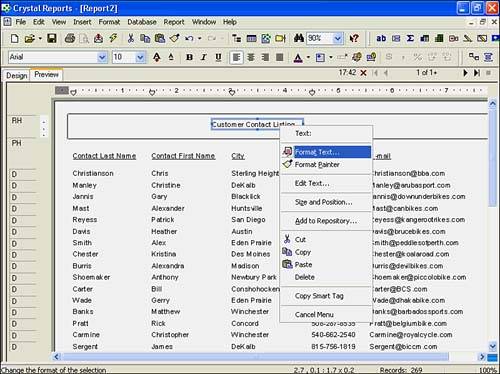
- The Format Editor dialog (displayed in Figure 6.8) enables you to set and adjust a variety of properties of the object. For this exercise, navigate to the Font tab of the Format Editor and select the Bold font style, a font size of 14, and a font color of Red. Also, select the Paragraph tab of the Format Editor and choose Centered from the Horizontal Alignment drop-down list.
Figure 6.8. The Format Editor dialog provides for quick and easy access to a variety of report object properties.
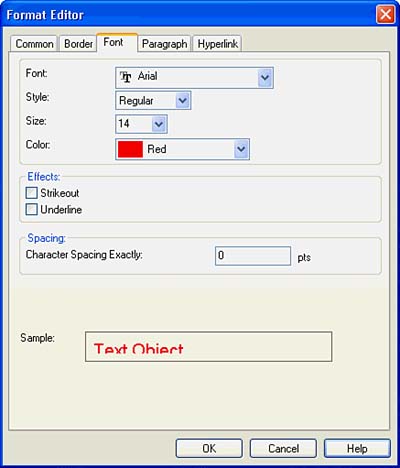
- Now select the Border tab from within the Format Editor and then select Single from each of the four border Line Style drop-down lists (left, right, top, and bottom). Under Color, click the Background check box and select Yellow from the drop-down list as the background color. Based on all of your selected properties in the Format Editor, you should now see a representative example of the text object in the Sample area at the bottom of the dialog box. Click OK to save these settings and return to the Design tab on your report.
- To improve the effectiveness of your report, you can modify the database field column titles to provide more meaningful descriptions for the business users of your report.
Working within the Design tab of your report, double-click on the Phone object in the Page Header section of the report. When the cursor's focus is on this object, you can delete, append, or update the text as you choose. Modify this text to read Telephone # and then click anywhere outside the object to remove the cursor's focus from the object.
As an alternative to the Format Editor, you can also use the toolbar and menu commands to quickly apply common formatting techniques, such as font and alignment characteristics.
- From the View menu, select Toolbars to present the Toolbar dialog. Make sure that the Standard, Formatting, and Insert toolbar items are all selected and click OK.
- Click on the Preview tab to see a preview display of what the report will actually look like. Again, if the Preview tab is not displayed in the application, click the Refresh toolbar button to execute the report. From the Preview mode, hold down either the Shift or Ctrl key on your keyboard and click each of the five column titles so that they are all highlighted with a dashed perimeter. With all five columns title fields highlighted, click the Bold toolbar button, represented with a large bold letter B on the formatting toolbar. See to Figure 6.9 to see the results of this action.
Figure 6.9. Common formatting properties can be quickly specified via the formatting toolbar commands (such as font styles, font size, colors, borders, and so on).
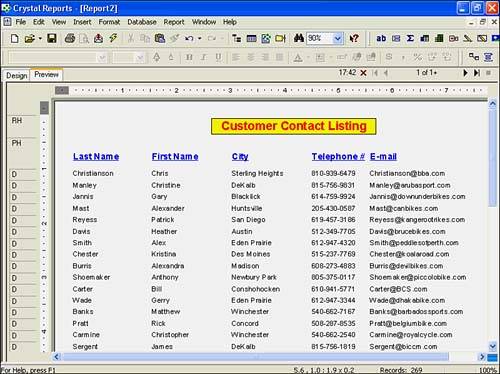
- With the five column title fields still highlighted, click the downward arrow located on the Font Color toolbar button, represented with an underlined letter A on the formatting toolbar. Select the bright blue color from the available list, as shown in Figure 6.9. Lastly, remove the contact prefix for the name fields and increase the size of these column titles to font size 12 with either the font size drop-down box or the A+ increase font size button. The fields might need to be stretched vertically to fit the new font size but can eventually be made to look like Figure 6.9.
To make the E-mail field appear more meaningful to the business users of the report, let's format the E-mail database field values to resemble and behave like standard hyperlink text.
- To remove the cursor focus from the five column titles fields, click anywhere outside these field areas or press the Esc (escape) key on your keyboard.
- Click any of the actual E-mail field values to highlight the E-mail database field objects and right-click on the same object to present the pop-up menu. From the pop-up menu, shown in Figure 6.10, select the Format Field item.
Figure 6.10. Right-clicking on any field object presents you with a list of commands for that particular object.
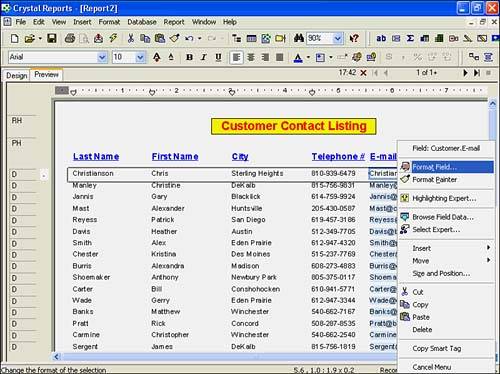
- Select the Hyperlink tab after you have opened the Format Editor. From the available Hyperlink Types, select Current E-mail Field Valuethis option automatically creates a hyperlink based on the values stored within this field in the data source assuming that these values are formatted as proper e-mail addresses in the data source, such as abc@domain.com.
NOTE
You can use the Hyperlink tab within the Format Editor to create hyperlinks to a Web site, e-mail address, file, or another Crystal Report. A hyperlink is saved with your report and is available to other users as a way of linking to additional external information from your report. Hyperlink definitions can also be defined by formulas thus enabling context-sensitive, data-driven hyperlinksa very powerful feature of Crystal Reports.
- Now let's make the E-mail field appear as a standard hyperlink value, commonly known to have a blue underlined font style. Select the Font tab within the Format Editor dialog to apply the blue font color and select the Underline check box. Click OK to return to the report Preview, and then press Esc to remove the cursor focus from all report objects.
- Based on the completion of the previous step, your mouse pointer should now change into a hand icon as it floats over any of the E-mail field values on the report. This indicates that upon clicking on any of the E-mail values, you initiate an e-mail message to be sent to that address, as shown in Figure 6.11.
Figure 6.11. By applying an e-mail hyperlink, report end users can initiate a context-sensitive e-mail to any of the respective customer contacts.
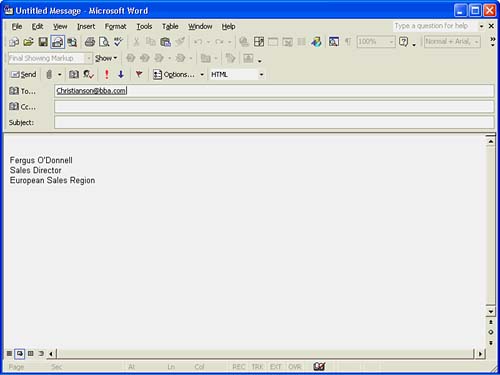
By using the Format Editor, as well as the Toolbar commands, to modify report object properties, you have very quickly and easily enhanced your report's presentation quality. Not only did you enhance this report example visually, but you also easily incorporated hyperlink functionality to add an additional level of interactivity to your report.
For more information on using hyperlink functionality in reports, see Chapter 9, "Custom Formatting Techniques."
Part I. Crystal Reports Design
Creating and Designing Basic Reports
- Creating and Designing Basic Reports
- Introducing the Crystal Reports Designer
- Understanding Data and Data Sources
- Introduction to the Data Explorer
- Adding Database Objects to Your Report
- Joining Database Objects Together
- Understanding the Different Join Types
- Using the Report Creation Wizards
- Understanding the Crystal Reports Gallery
- Using the Standard Report Creation Wizard
- Creating a Report Without Wizards
- Troubleshooting
Selecting and Grouping Data
- Selecting and Grouping Data
- Introduction
- Understanding Field Objects
- Working with Groups
- Understanding Drill-down Reports
- Troubleshooting
Filtering, Sorting, and Summarizing Data
- Filtering, Sorting, and Summarizing Data
- Introduction
- Filtering the Data in Your Report
- Learning to Sort Records
- Working with the Sort Expert
- Creating Effective Summaries
- Troubleshooting
Understanding and Implementing Formulas
- Understanding and Implementing Formulas
- Introduction
- Using the Formula Workshop
- Using the Workshop Formula Editor
- Creating Formulas with the Formula Expert
- Using the Formula Extractor to Create Custom Functions
- The Multi-Pass Reporting Process of the Crystal Reports Engine
- Troubleshooting
Implementing Parameters for Dynamic Reporting
- Implementing Parameters for Dynamic Reporting
- Introduction
- Understanding the Value of Parameters
- Creating and Implementing Parameters Fields
- Using Parameters with Record Selections
Part II. Formatting Crystal Reports
Fundamentals of Report Formatting
- Fundamentals of Report Formatting
- Introduction
- Positioning and Sizing Report Objects
- Modifying Object Properties for Formatting Purposes
- Exploring the Format Editor Dialog Common Options
- Combining and Layering Report Objects
- Configuring Report Page and Margin Properties
Working with Report Sections
- Working with Report Sections
- Introduction
- Formatting Report Sections
- Modifying Report Section Properties
- Using Multiple Report Sections
- Troubleshooting
Visualizing Your Data with Charts and Maps
- Visualizing Your Data with Charts and Maps
- Introduction to Charts and Maps
- Using the Chart Expert
- Using the Map Expert
- Modifying Chart and Map Properties
- Troubleshooting
Custom Formatting Techniques
- Introduction
- Making Presentation-Quality Reports
- Common Formatting Features
- Conditional Formatting Using Data to Drive the Look of a Report
Part III. Advanced Crystal Reports Design
Using Cross-Tabs for Summarized Reporting
- Using Cross-Tabs for Summarized Reporting
- Introduction to Cross-Tabs
- Benefits of Cross-Tabs
- Using the Cross-Tab Wizard
- Using Top N with Cross-Tabs Reports
- Using Advanced Cross-Tab Features
Using Record Selections and Alerts for Interactive Reporting
- Using Record Selections and Alerts for Interactive Reporting
- Creating Advanced Record Selection Formulas
- Adding Alerting to Your Reports
- Performance Monitoring and Tuning
Using Subreports and Multi-Pass Reporting
- Using Subreports and Multi-Pass Reporting
- Understanding Subreports
- Understanding Linked Versus Unlinked Subreports
- Considering Subreport Execution Time and Performance
- Using Variables to Pass Data Between Reports
- Emulating Nested Subreports
- Troubleshooting
Using Formulas and Custom Functions
- Using Formulas and Custom Functions
- Becoming More Productive with Formulas
- Choosing a Formula Language: Crystal Versus Basic Syntax
- Using Brackets in Formulas
- Using Characters in Formulas
- Recent Improvements to Formulas
Designing Effective Report Templates
- Designing Effective Report Templates
- Understanding the Importance of Reuse in Reporting
- Understanding Report Templates
- Using Report Templates
- Using Existing Crystal Reports as Templates
- Understanding How Templates Work
- Creating Useful Report Templates
- Using Template Field Objects
- Using Report Templates to Reduce Report Creation Effort
- Applying Multiple Templates
Additional Data Sources for Crystal Reports
- Additional Data Sources for Crystal Reports
- Understanding the Additional Crystal Reports Data Sources
- Connecting to COM-based Data Sources
- Connecting to Java-based Data Sources
- Understanding Solution Kits for Crystal Enterprise
- Troubleshooting
Multidimensional Reporting Against OLAP Data with Crystal Reports
- Multidimensional Reporting Against OLAP Data with Crystal Reports
- Introduction to OLAP
- OLAP Concepts and OLAP Reporting
- Recently Added or Changed OLAP Features in Crystal Reports
- Using the OLAP Report Creation Wizard and OLAP Expert
- Advanced OLAP Reporting
- Introduction to Crystal Analysis
Part IV. Enterprise Report Design Analytic, Web-based, and Excel Report Design
Introduction to Crystal Repository
- Introduction to Crystal Repository
- What Is the Crystal Repository?
- Why Implement the Crystal Repository?
- Installing the Crystal Repository
- Adding Objects to and from the Repository
- Migration of the Crystal Enterprise Repository
- Troubleshooting
Crystal Reports Semantic Layer Business Views
- Crystal Reports Semantic Layer Business Views
- Introduction to Business Views
- Why Implement Business Views?
- Performance and Implementation Considerations
- Business Views Architecture and Implementation
- Troubleshooting
Creating Crystal Analysis Reports
- Creating Crystal Analysis Reports
- Introduction
- Introducing Crystal Analysis
- Accessing OLAP Data with Crystal Analysis
- Designing Crystal Analysis Reports and Applications
- Adding Crystal Analysis Objects to a Report
- Troubleshooting
Advanced Crystal Analysis Report Design
- Advanced Crystal Analysis Report Design
- Introduction
- Advanced Crystal Analysis Designer Tools
- Custom Calculations and Advanced Data Analysis
- Setting Report Options
- Troubleshooting
- Crystal Analysis in the Real World MDX
Ad-Hoc Application and Excel Plug-in for Ad-Hoc and Analytic Reporting
- Ad-Hoc Application and Excel Plug-in for Ad-Hoc and Analytic Reporting
- Introducing Ad-Hoc Reporting Conceptually
- Introducing the Crystal Enterprise Ad-Hoc Reporting Application
- Crystal Reports Excel Plug-in
- Crystal Analysis Excel Plug-in
Part V. Web Report Distribution Using Crystal Enterprise
Introduction to Crystal Enterprise
- Introduction to Crystal Enterprise
- What Is Crystal Enterprise?
- Why Implement a Crystal Enterprise Solution?
- Versions of Crystal Enterprise
- Understanding the Core Functions of Crystal Enterprise
Using Crystal Enterprise with Web Desktop
- Using Crystal Enterprise with Web Desktop
- Introduction
- Crystal Enterprise User Launchpad
- Crystal Enterprise Web Desktop
- Customizing the Web Desktop and Report Viewers
- Publishing to the Web Desktop
- Customizing the Web Desktop
- Troubleshooting
Crystal Enterprise Architecture
- Crystal Enterprise Architecture
- Introduction
- Crystal Enterprise Architecture Overview
- The Client Tier
- The Application Tier
- The Server Tier: Introduction to the Crystal Enterprise Framework
- The Server Tier: Overview of the Crystal Enterprise Services
- The Data Tier
- The Crystal Enterprise Architecture in Action
- Taking Advantage of the Crystal Enterprise Distributed Architecture
- Extending Crystal Enterprise
Planning Considerations When Deploying Crystal Enterprise
- Planning Considerations When Deploying Crystal Enterprise
- Ensuring a Successful Crystal Enterprise Implementation
- Approaching the Project
- Identifying Business Pain
- Establishing Project Requirements
- Understanding Organizational Reporting Requirements
- Troubleshooting
Deploying Crystal Enterprise in a Complex Network Environment
- Deploying Crystal Enterprise in a Complex Network Environment
- Introduction
- Understanding Network Protocols
- Understanding Firewall Types
- Configuring the Crystal Enterprise Architecture for Your Network Environment
- Interaction Between the WCS and the WC
- Deploying Crystal Enterprise with an IP Packet Filtering Firewall
- Using Crystal Enterprise with NAT
- Exploring the NAT and Crystal Enterprise Relationship
- Crystal Enterprise and Proxy Servers
Administering and Configuring Crystal Enterprise
- Introduction
- Using the Crystal Management Console
- Managing Accounts
- Managing Content
- Introducing Servers
- Managing Crystal Enterprise System Settings
- Using the Crystal Configuration Manager
Part VI. Customized Report Distribution Using Crystal Reports Components
Java Reporting Components
- Java Reporting Components
- Overview of the Crystal Reports Java Reporting Component
- Understanding the Java Reporting Components Architecture
- Differences with the Java Reporting Engine
- Configuring the Application Server
- Delivering Reports in Web Applications
- Using the Crystal Tag Libraries
- Exporting Reports to Other File Formats
- Printing Reports from the Browser
- Common Programming Tasks
- Troubleshooting
Crystal Reports .NET Components
- Crystal Reports .NET Components
- Understanding Microsofts .NET Platform
- Understanding the Different Crystal .NET Components
- An Overview of the Crystal Reports 10 .NET Components
- The Report Designer
- The Report Engine Object Model
- Delivering Reports with the Windows Forms Viewer
- Delivering Reports with the Web Forms Viewer
- Database Credentials
- Setting Parameters
- Troubleshooting
COM Reporting Components
- COM Reporting Components
- Understanding the Report Designer Component
- Building Reports with the Visual Basic Report Designer
- Programming with the Report Engine Object Model
- Delivering Reports Using the Report Viewer
- Troubleshooting
Part VII. Customized Report Distribution Using Crystal Enterprise Embedded Edition
Introduction to Crystal Enterprise Embedded Edition
- Introduction to Crystal Enterprise Embedded Edition
- Introduction to Crystal Enterprise Embedded Edition
- Understanding Crystal Enterprise Embedded Edition
- Crystal Enterprise Embedded Edition Samples
- DHTML Report Design Wizard
- Troubleshooting
Crystal Enterprise Viewing Reports
- Crystal Enterprise Viewing Reports
- Viewing Reports over the Web
- Introduction to the Crystal Report Viewers
- Understanding the Report Source
- Implementing the Page Viewer
- Implementing the Part Viewer
- Implementing the Interactive Viewer
- Implementing the Grid Viewer
- Troubleshooting
Crystal Enterprise Embedded Report Modification and Creation
- Introduction
- Deploying RAS Environments
- Loading Report Files
- Locating RAS Components in a Network Architecture
- Installing the RAS SDK
- Best Practices in RAS Exception Handling
- The RAS SDK in Action
Part VIII. Customized Report Distribution Using Crystal Enterprise Professional
Introduction to the Crystal Enterprise Professional Object Model
- Introduction to the Crystal Enterprise Professional Object Model
- Understanding the Crystal Enterprise Object Model
- Establishing a Crystal Enterprise Session
- Querying the Crystal Enterprise Repository
- Viewing Reports
- The Crystal Enterprise Java SDK
- Accessing the Java SDK
- Troubleshooting
Creating Enterprise Reports Applications with Crystal Enterprise Part I
- Creating Enterprise Reports Applications with Crystal Enterprise Part I
- Advanced Scenarios with the Crystal Enterprise Object Model
- Scheduling Reports
- Scheduling to a Destination
- Using Crystal Enterprise Notifications
- Scheduling to a Server Group
- Scheduling to a Specific Format
- Setting Database Credentials
- Troubleshooting
Creating Enterprise Reporting Applications with Crystal Enterprise Part II
- Creating Enterprise Reporting Applications with Crystal Enterprise Part II
- Querying the Crystal Enterprise InfoStore
- Creating and Responding to Crystal Enterprise Alerts
- Creating Schedulable Program Objects
- Troubleshooting
Appendix A. Using Sql Queries In Crystal Reports
Creating Enterprise Reporting Applications with Crystal Enterprise Part II
EAN: 2147483647
Pages: 341
